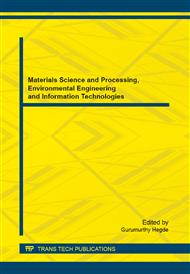p.495
p.499
p.505
p.509
p.513
p.517
p.521
p.528
p.534
Ecological Risk Assessment of Oxytetracycline Bacteria Residue in the Process of Fertilizing
Abstract:
This study uses identification of hazards, predicting no-effect concentration, predicting environmental concentration and risk characterization to assess the ecological risk of oxytetracycline bacteria residue in fertilizing process, and calculates the ecological risk value about soil microbial, soil-plant, soil animals and soil drug-resistant bacteria. Besides, a risk characterization model of oxytetracycline bacteria residue in soil is built. The results show that the ecological risk in alluvial soil and black soil are negligible, and the ecological risk in red soil can be reduced in the untreated condition. All the ecological risk fertilizer in alluvial soil, black soil and red soil are negligible when it is disposal of 80%.
Info:
Periodical:
Pages:
513-516
Citation:
Online since:
October 2014
Authors:
Price:
Сopyright:
© 2014 Trans Tech Publications Ltd. All Rights Reserved
Share:
Citation:


